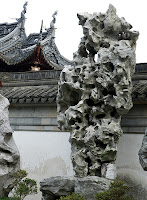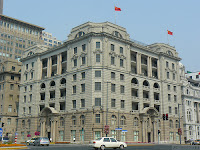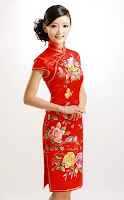Chapter Five
Sparkling Nanjing Road of Shanghai
Shanghai's most famous thoroughfare, Nanjing Road stretches across the central city of Shanghai and next to Huangpu River in the east, the cross point of Jing'an Temple and West Yan'an Road. It is 5.5 km in full length, enjoys the reputation as China No. 1 commercial center. It was the earliest commercial street in Shanghai since the city opened to the outside world.
Yesterday of Nanjing Road
Nanjing Road enjoys a history of over 100 years and used to be called “Parker Lane”. It was named Nanjing Road officially in 1865 and turned into a pedestrian road in 1999.
After the Opium War (1839-1842), Shanghai became a treaty port. Nanjing Road was first the British Concession, then the International Settlement. Importing large quantities of foreign goods, it became the earliest shopping street in Shanghai. -- A series of franchised stores were set up at that time.
Eight big department stores were established along the street one after another.
 |
| The Old Phoenixes |
1. The Old Phoenixes (老凤祥): It was created in 1848, and it is the only century old shop that has been handed down for 1.5 centuries. The jewelry there is pretty well-known, especially the ornaments made from gold, silver and diamonds.
2. Zhang Xiao Quan (张小泉): The scissors sold at this store can shear silk fabric without leaving any redundant silk: first, they are smooth in shearing cloth; second, they never rusts; third, on the handles of the scissors there are graphic patterns. All of the characteristics make people fondle them admiringly.
 |
| Fresh pork moon cake |
3. Lao Da Fang (老大房): Smoked fish and fresh pork moon cakes are the most characteristic there. The sugar sauce on the outside of the smoked fish tastes both salty and sweet, and is crisp both outside and inside. It is said that the moon cakes are made with a secret recipe handed down from the ancestors.
4. Cai Tong De (蔡同德): The store was created in the first year of Guangxv of the Qing Dynasty (1882), which is an old and famous traditional Chinese medicine shop that was the earliest business to start and is the most large-scale. All along, it was an expert in producing and managing nourishing plaster and wine.
5. Wu Liang Cai (吴良才): it specialize in various glasses of high qualities and also among the old and famous shops of old Shanghai on Nanjing Road.
 |
| Shao Wan Sheng |
6. Shao Wan Sheng (邵万生): The shop specializes in the wine-preserved food of Ningbo and Shaoxing flavors, and the most famous two are wine-preserved winkles and wine-preserved crabs.
7. Shen Da Cheng (沈大成): All kinds of desserts and locally flavored snacks are sold there, among which, pastry balls are the most famous.
8. Duo Yun Pavilion (朵云轩): The store mainly sells Chinese paintings and calligraphy, and relevant writing materials; the store’s woodblock printing and Beijing’s Rong Bao Room are famous respectively in the South and in the North.
Today of Nanjing Road
Over time, Nanjing Road has been restructured, undergoing significant change. With the development of over one hundred years, the Nanjing Road becomes the must-see place of metropolitan destination attracting thousands of shoppers seek fashion here from all over the world as it also shows the bustling Shanghai with charm and glamour.
For shopping convenience, its eastern end has an all-weather pedestrian arcade. Big traditional stores no longer dominate the market since modern shopping malls, specialty stores, theatres and international hotels have mushroomed on both sides of the street.
There are more than 360 malls, department stores, specialized shops, restaurants and cultural and recreational facilities. In the daytime, the street is crowned with visitors and when the night falls, flashing neon signs illuminate the magnificent buildings and spangle the night skyline of Shanghai.
No doubt, Nanjing Road is the most luxury street in Shanghai. Nanjing Street is a comprehensive shopping center which integrates tourism, business and culture together. The Pedestrian way of Nanjing Road where there is no crowded traffic but it is prosperous and elegant. You will feel pretty pleased when doing your shopping, relaxing and tasting delicious food there.
Below will recommend where and how to enjoy your wander in Nanjing Road.--
 |
| Ann department Store in Nanjing Road |
1. The "Golden Belt": the 4.2 meter wide "golden belt" is set 1.3 meters northward of the Nanjing Road axis. It runs through the whole pedestrianized area. There are urban public facilities such as seats, shopping booths, enquiry booths, signboards, small sculptures, street lights, trash boxes, parterres, telephone booths and so on. Every standard unit of the golden belt is 75 meters long and there is enough north-south walking space for tourists to run across the "golden belt" freely.
2. The Manhole Covers: all of the 37 manhole covers on the "golden belts" were designed specially and everyone has different graphic patterns that are carved on it — each period’s embossments of the representative buildings and structures since Shanghai’s opening to the outside world, which are labeled with the building year and all of which are cast with gold and copper. The 37 manhole covers concentrate the development of Shanghai’s urban construction of over 100 years.
3. Sculptures: on the "golden belt", there are three groups of sculptures made of casting copper, which are “a family of three people”, “young married women” and “the mother and the daughter”. All the sculptures used the proportions of real people and adopted the skill of realism.
 |
| Nanjing Road in Day |
4. A Different Scene: in many people’s opinion, a shopping street will always be full of crowds, material, commercial and modern. However, if you get up early and came to Nanjing Road in the morning, you will surprisingly find it total different scenery: shops along the street are all closed; only the dustman is busy with cleaning. In the street, the residents are dancing to the music, playing badminton, practicing Taichi, etc. It is more like a park rather than a shopping area. This is another charming side of Nanjing Road.
Do you eager to go to wandering on this road now? --Standing in the center of Nanjing road at night to experience its bustle and prosperous while find out its old Shanghai atmosphere will be so great that you can never miss.



















